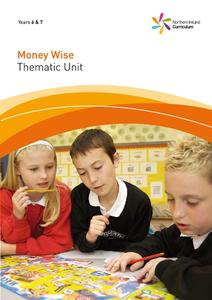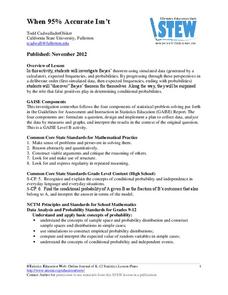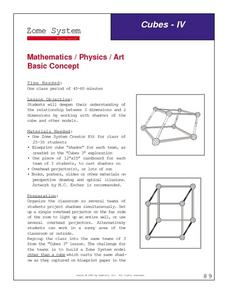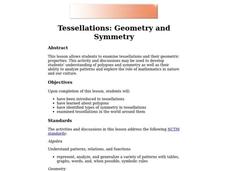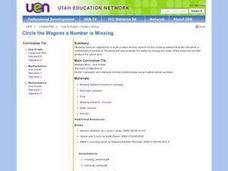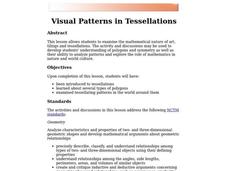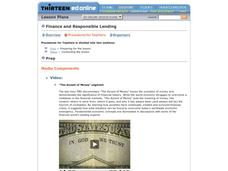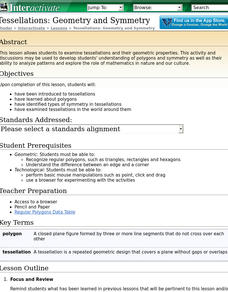Pennsylvania Department of Education
Modeling Spatial Relationships
Students model spatial relationships using math manipulatives. In this spatial relationships lesson, students work with a partner, and either connecting links or linking cubes that are three different colors. They explain to each other...
Northern Ireland Curriculum
Money Wise
Does money seem to slip through your middle schoolers' fingers? Encourage them to examine spending, saving, and budgeting habits with a unit on consumer skills and money management. Young spenders study the waste that occurs with school...
Illustrative Mathematics
Tilt of Earth's Axis and the Four Seasons
Geometry meets earth science as high schoolers investigate the cause and features of the four seasons. The effects of Earth's axis tilt features prominently, along with both the rotation of the earth about the axis and its orbit about...
Curated OER
Economic Goals and Measuring Activity
Explore the role of government in the economy market. Young scholars analyze the economic decision-making process and how it takes into consideration additional cost, benefits, and public awareness of what they are trying to accomplish....
Statistics Education Web
When 95% Accurate Isn’t
Investigate the effect of false positives on probability calculation with an activity that asks scholars to collect simulated data generated by a calculator. To finish, participants analyze the probability of certain outcomes which lead...
Illustrative Mathematics
Start/Stop Counting II
Take stroll around the classroom while teaching young mathematicians to count fluently with this whole-group math activity. The teacher starts things off by walking around the room while counting up from the number one and continues...
EngageNY
Increasing and Decreasing Functions 1
Model situations with graphs. In the fourth installment of a 16-part module, scholars learn to qualitatively analyze graphs of piecewise linear functions in context. They learn to sketch graphs for different situations.
Curated OER
Inflation and Unemployment
Students explore the role of government in the economy market. In this economics lesson, students analyze the decision making and how it takes into consideration additional cost, benefits and public awareness of what they are trying to...
Curated OER
The Perfect City
Students analyze group influences on people, events and culture. They design their own perfect society and report it to the class.
Curated OER
Cubes-IV
Students examine the relationship between three dimensions and two dimensions by working with shadows of cubes and other models. Students work in groups and use Zome System Creator Kits to try and build a shape other than a cube that...
Curated OER
Introducing Linear Terminology
Ninth graders graph linear equations and inequalities in two variables and then, they write equations of lines and find and use the slope and y-intercept
of lines. They use linear equations to model real data and define to define the...
Curated OER
Tessellations: Geometry and Symmetry
Students examine tesselllations and their geometric properties. They have a better knowledge of polygons, can identify types of symmetry in tessellations. Also students use visulization, spatial reasoning, and geometric modeling to...
Curated OER
Circle the Wagons a Number is Missing
Second graders have an opportunity to work in pairs as they search for the missing addend to complete a mathematical sentence. They identify and demonstrate the ability to change the order of the addends and still produce the same sum....
Curated OER
History in the Making: The Tortilla
Fourth graders examine the history of the tortilla and extend the study across the curriculum. In this history of the tortilla lesson, 4th graders research the background of the tortilla, determine the ingredients, and work with the...
Curated OER
Getting to the Point
Students determine location by using the technique of triangulation. They imagine that they are out in the wilderness and have come to the top of a ridge. How can one identify the ridge on the topo map? How can one figure out where you...
Curated OER
Visual Patterns in Tessellations
Young scholars explore tessellations as well as various types of polygon. Students examine tessellating patterns in the world around them. Young scholars examine tessellations by creating their own tessellations and completing the...
Curated OER
Finance and Responsible Lending
Students learn the characteristics of economic systems through problem solving, communication and representation. In this financial lending lesson, students use math to solve problems dealing with the economy today, to work with their...
Curated OER
Maths With the Mob
Students are read a book about aboriginal women. They compare and contrast a few items out of the book. They examine their families and discuss them with the class.
Curated OER
Place Value Partners
In these place value game worksheets, students pair with a partner and use the game boards to place number tiles on the place value strips that list place values from ones to millions. Students place the tiles and name the digit and...
Curated OER
Geometry and Symmetry
Students examine tessellations and their geometric properties. The activity and discussions may be used to develop students' understanding of polygons and symmetry as well as their ability to analyze patterns.



